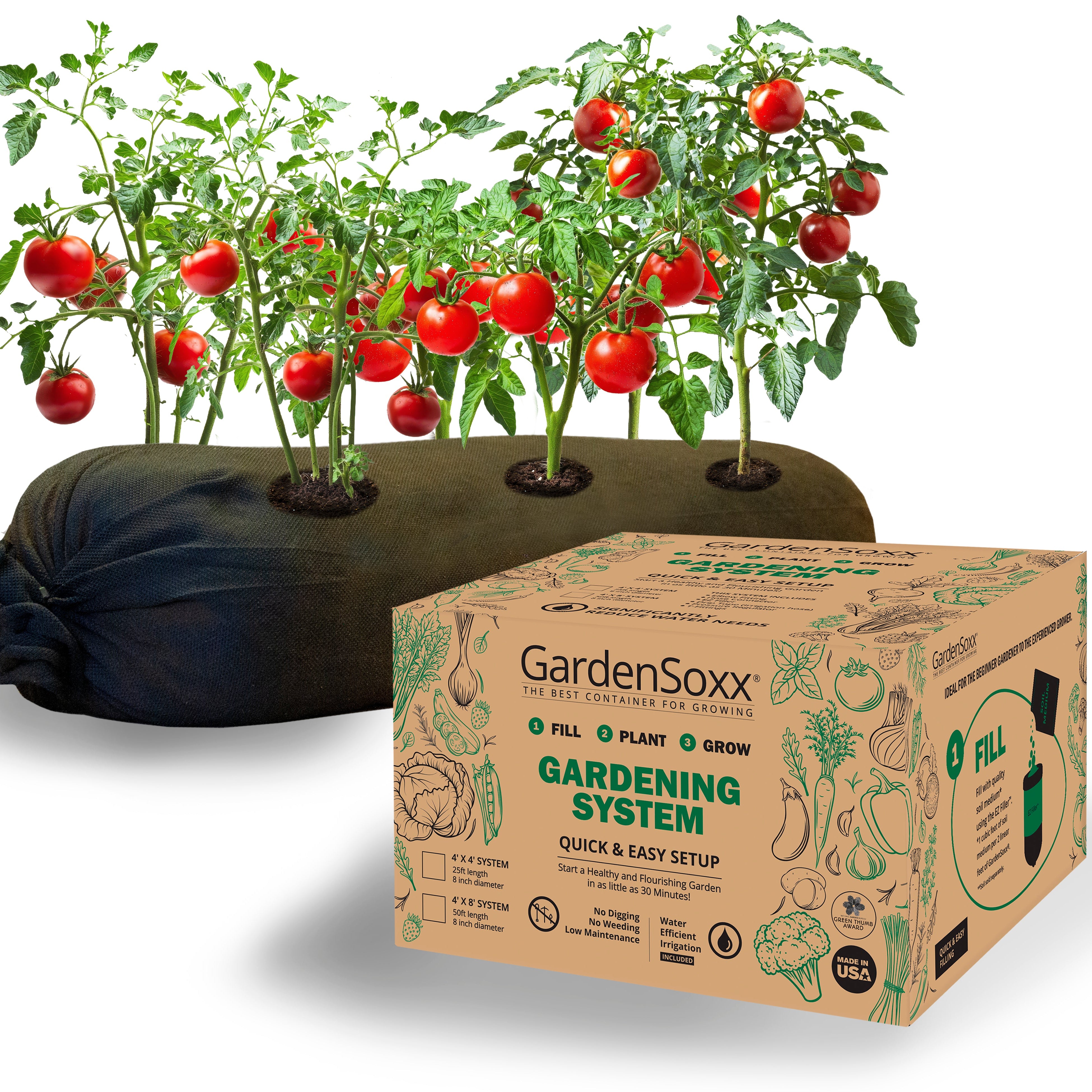Tomatoes
For anyone with an interest in gardening, often one of the first things to learn is how to grow tomatoes. There is nothing quite like plucking a sun-warmed, ripe tomato off its vine and enjoying it with fresh garden basil. With over ten thousand varieties to choose from, just one plant can yield between 10 - 15 pounds of tomatoes or more in a growing season. While technically a fruit, the tomato is used across all cultures in nearly every type of cuisine and is usually treated as a vegetable.
While almost 95% of the tomato’s weight is water, they are quite high in fiber. Their red color comes from the organic pigment Lycopene, which also has health properties when consumed, like protecting from the sun, supporting the heart, and reducing the risk of cancer.

Growing tomatoes in GardenSoxx® | Plant Family: Solanaceae (Nightshade)
Different Varieties of Tomatoes
With over ten thousand different varieties of tomatoes in existence, choosing the right one for your garden may not be a simple task. First, it is important to know the difference between indeterminate and determinate tomato plant varieties. Home and market growers tend to prefer indeterminate varieties, as the plant will keep growing and producing fruit throughout the season. Determinate tomato plant varieties are more compact and usually do not require staking. The plant will grow to a certain height, produce all its fruit, and then cease to grow. These varieties are typically preferred for sauces and preserves.
Fun and flavorful, Spoon tomatoes are a variety that produces what may very well be the world's smallest tomato! They are just about the size of currants and they offer a pop of sweet flavor, perfect for adding to fresh summer salads or tossing into a plate of fresh pasta. This heirloom indeterminate variety will produce a harvest in about 70 days or so.
For a cherry tomato that is one of the best heirloom tomatoes for containers, try the Tiny Tim variety. This plant stays small and compact while producing an abundance of sweet and tart snacking tomatoes about midway through the season. For maximum fruit growth, place this determinate plant in full sun - but know that Tiny Tim will also do well in partly shaded gardens.
Moving up slightly in size, the Candy Bell grape tomato is a delicious and reliable determinate variety that produces consistently-sized fruit and requires barely any pruning. The plant stays small and manageable and has a high resistance to common tomato diseases like fusarium and verticillium wilt. Fruit will mature in about 65 days from planting.
For an indeterminate grape-sized variety that produces a yellow tomato, the Yellow Pear is gaining popularity among northern growers. Their sweet, fruity flavor and highly prolific production make this heirloom variety a top choice for both market and home growers. While the plant will need staking, they do quite well in small gardens.
Gardeners looking for heat-tolerant tomato plants should consider growing Bella Rosa tomato plants - an easy-to-grow, firm but juicy, determinate variety that produces delicious medium-sized tomatoes in about 70 days from planting. Known to produce high yields, this disease-resistant cultivar is one of the best tomato varieties to grow.
Available in red, yellow, pink or black, the Brandywine tomato variety is a popular slicer tomato plant that produces consistently large, meaty tomatoes that are perfect for enjoying all summer long. The indeterminate plants grow tall and will require staking, but will produce tomatoes through to the end of summer and even into fall if the weather stays warm.
Nutritional Information For Tomatoes
Nutritional Facts - per 100/g
| Nutrient | Amount | % Daily Value |
|---|---|---|
| Calories | 20 | - |
| Total Fat | 0.3 g | - |
| Sodium | 5 mg | - |
| Potassium | 215 mg | - |
| Dietary Fiber | 1.1 g | - |
| Sugar | 2.4 g | - |
| Protein | 0.8 g | - |
| Vitamin C | - | 14% |
| Iron | - | 2% |
| Vitamin A | - | 5% |
| Calcium | - | 1% |
How to Grow Tomatoes in Your GardenSoxx®
Tomatoes love the sun and heat and will grow best when given a good amount of both. While seeds can be started indoors, many gardeners choose to simply purchase their tomato plants from a nursery to save them the trouble of having to harden off the seedlings before putting them in the soil. Tomato seedlings should only go into the soil well after the last frost date when the weather is consistently on the warmer side.
Add a stake next to the tomato at the time of planting so that it can support the plant as it grows (adding the stake after the plant has been established can cause damage to the plant roots). As the tomato plant grows, remove the “suckers” (the small branches that grow at a 45-degree angle between the main stem and branches) so that the plant grows straight and remains sturdy.
Tomato Seed to Harvest Time: 50 - 100 days depending on the variety

How to Harvest Tomatoes
Wait for tomatoes to blush and pick them off the vine while they are still firm and showing some color. They can continue to ripen on the counter. If the weather turns cold and you are left with green tomatoes on your vine that are not turning red, remove them and place them in a cardboard box in a cool, dry spot in your home. They will take time, but will eventually ripen. Green tomatoes can also be used in some recipes and for pickling.


















































